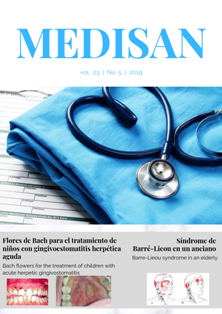Clinical and Neuropsychological Profile of Possible Alzheimer subtype neurocognitive disorder
Keywords:
mild cognitive disorder, major cognitive disorder, dementia, Alzheimer.Abstract
Introduction: Alzheimer disease is presented with different neuropsychological phenotypes and it is considered that the memory disorder is its most important one; however, recent studies suggest that the dysfunctions in the executive functions can constitute very early markers of the disease.
Objectives: To characterize the clinical and neuropsychological profiles that constitutes phenotypical markers of the neurocognitive disorders possible Alzheimer subtype.
Methods: A descriptive and cross-sectional study of 39 sick persons with ages between 57-85 years, classified according to the DSM-5 criteria, with cognitive mild and major disorder, classified from the etiological point of view in the possible Alzheimer subtype was carried out. Multiple cognitive domains were evaluated (complex attention, memory and learning, executive functions, language, motor and perceptual functions) and a detailed evaluation of the executive functions was made by means of a group of specific neuropsychological tests.
Results: The statistical analysis demonstrated that comparing the two study groups with cognitive disorder, significant differences exist as for the level of cognitive performance in all the explored domains, except in the perception and motor functions. Likewise, the results demonstrated that the yielding level for each function evaluated within the domain of the executive functions is significantly different between both groups with cognitive disorder, except for the space orientation.
Conclusions: The neuropsychological profile of the cognitive disorder Alzheimer possible subtype was characterized by a disorder in multiple domains, with predominance of the focused executive dysfunction in the areas of the mental flexibility and inhibition of automatisms.
Downloads
References
2. Prince M, Wimo A, Guerchet M, Claire MG, Tzu Wu Y, Prina M. World Alzheimer Report. The global impact of dementia an analysis of prevalence, incidence, cost and trends. London: Alzheimer’s Disease International; 2015 [citado 27/05/2019]. Disponible en: https://www.alz.co.uk/research/worldalzheimerreport2015summary.pdf
3. Alzheimer Society of Canada. Normal aging vs dementia, 2016 [citado 27/05/2019]. Disponible en: https://alzheimer.ca/en/Home/About-dementia/What-is-dementia/Normal-aging-vs-dementia
4. Rae-Grant A, Fedorowics Z, Ehrlich A. Mild cognitive impairment [citado 19/06/2018]. Disponible en: https://www.alzheimers.org.uk/about-dementia/types-dementia/mild-cognitive-impairment-mci
5. Petersen RC, Lopez O, Armstrong MJ, Getchius TSD, Ganguli M, Gloss D, et al. Practice guideline update summary: Mild cognitive impairment: Report of the Guideline Development, Dissemination, and Implementation Subcommittee of the American Academy of Neurology. Neurology. 2018 [citado 19/06/2018];90(3):126-35. Disponible en: https://www.ncbi.nlm.nih.gov/pubmed/29282327
6. Dimitriadis S, Laskaris N, Bitzidou M, Trananas I, Tsokali M, et al. A novel biomarker of amnestic MCI based on dynamic cross-frequency coupling patterns during cognitive brain responses. Fron Neurosci. 2015 [citado 02/10/2018]; 9:350. Disponible en: https://www.ncbi.nlm.nih.gov/pmc/articles/PMC4611062/
7. Prince M, Albanesse E, Guertchet M, Prina M. World Alzheimer Report 2014, [citado 12/02/2018] Disponible en: https://www.alz.co.uk/research/WorldAlzheimerReport2014.pdf
8. Colloby S, Cromarty R, Peraza L, Johnsen K, Jóhannesson G, Bonanni L, et al. Multimodal EEG-MRI in the differential diagnosis of Alzheimer´s disease and dementia with Lewy bodie. J Psychiatry Res. 2016; 78: 48-55.
9. American Psychiatric Association. Diagnostic and Statistical Manual of Mental Disorders (DSM-5). 5th ed. Arlington: American Psychiatric Publishing; 2013.
10. American Psychiatric Association. Diagnostic and Statistical Manual of Mental Disorders (versión actualizada). Arlington: American Psychiatric Association; 2015.
11. Contreras J, Goñi J, Risacher S, Sporns O, Saykin AJ. The structural and functional connectome and prediction of Rrisk for cognitive impairment in older adults. Curr Behav Neurosci Rep. 2015 [citado 02/10/2018];2(4):234-45. Disponible en: https://www.ncbi.nlm.nih.gov/pmc/articles/PMC4809258/
12. Babiloni C, Triggiani AI, Lizio R, Cordone S, Tattoli G, Bevilacqua V, et al Classification of single normal and Alzheimer´s Disease Individuals from cortical sources of resting state EEG Rhythms. Front Neurosci. 2016 [citado 02/10/2018]; 23; 10:47. Disponible en: https://www.ncbi.nlm.nih.gov/pubmed/26941594
13. López ME, Turrero A, Cuesta P, López-Sanz D, Bruña R, Marcos A. Searching for primary predictors of conversions from mild cognitive impairment to Alzheimer´s disease: a multivariate follow-up study. J Alzheimers Dis. 2016 [citado 02/10/2018]; 52(1):133-43. Disponible en: https://www.ncbi.nlm.nih.gov/pubmed/27060953
14. Díaz Mardomingo MDC, García Herranz S, Rodríguez Fernández R, Venero C, Peraita H. Problems in Classifying Mild Cognitive Impairment (MCI): one or multiple syndromes? Brain Sci. 2017; 7(9): 111.
15. Tamayo M, Casals Colla G, Sánchez Benavidesa M, Quintanaa RM, Manerob T, Rognonia L, et al. Estudios normativos españoles en población adulta joven (Proyecto Neurona Jóvenes): normas para las pruebas span verbal, span visuoespacial, Letter-Number Sequencing, Trail Making Test y Symbol Digit Modalities Test. Neurología. 2012 [citado 02/10/2018];27(6):319-29. Disponible en: https://www.clinicalkey.es/service/content/pdf/watermarked/1-s2.0-S0213485312000217.pdf?locale=es_ES&searchIndex
16. Siberski J. Dementia and DSM-5: Changes, cost, and confusion. Aging Well. 2012 [citado 02/10/2018];5(6). Disponible en: https://www.todaysgeriatricmedicine.com/archive/110612p12.shtml
Published
How to Cite
Issue
Section
License
All the articles can be downloaded or read for free. The journal does not charge any amount of money to the authors for the reception, edition or the publication of the articles, making the whole process completely free. Medisan has no embargo period and it is published under the license of Creative Commons, International Non Commercial Recognition 4.0, which authorizes the copy, reproduction and the total or partial distribution of the articles in any format or platform, with the conditions of citing the source of information and not to be used for profitable purposes.





